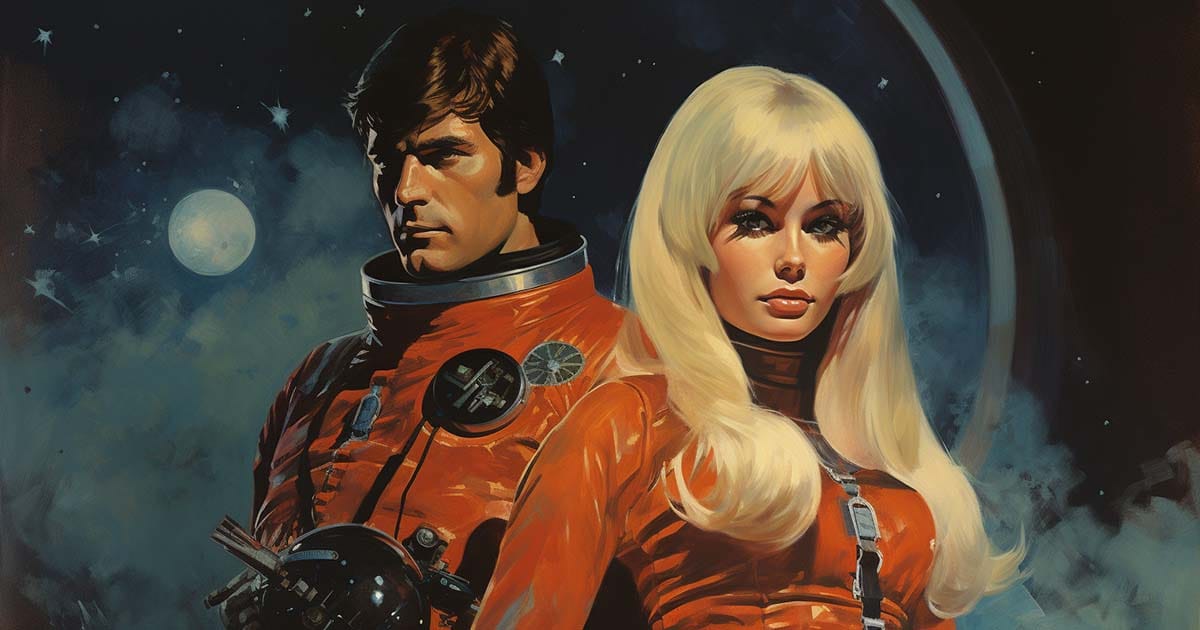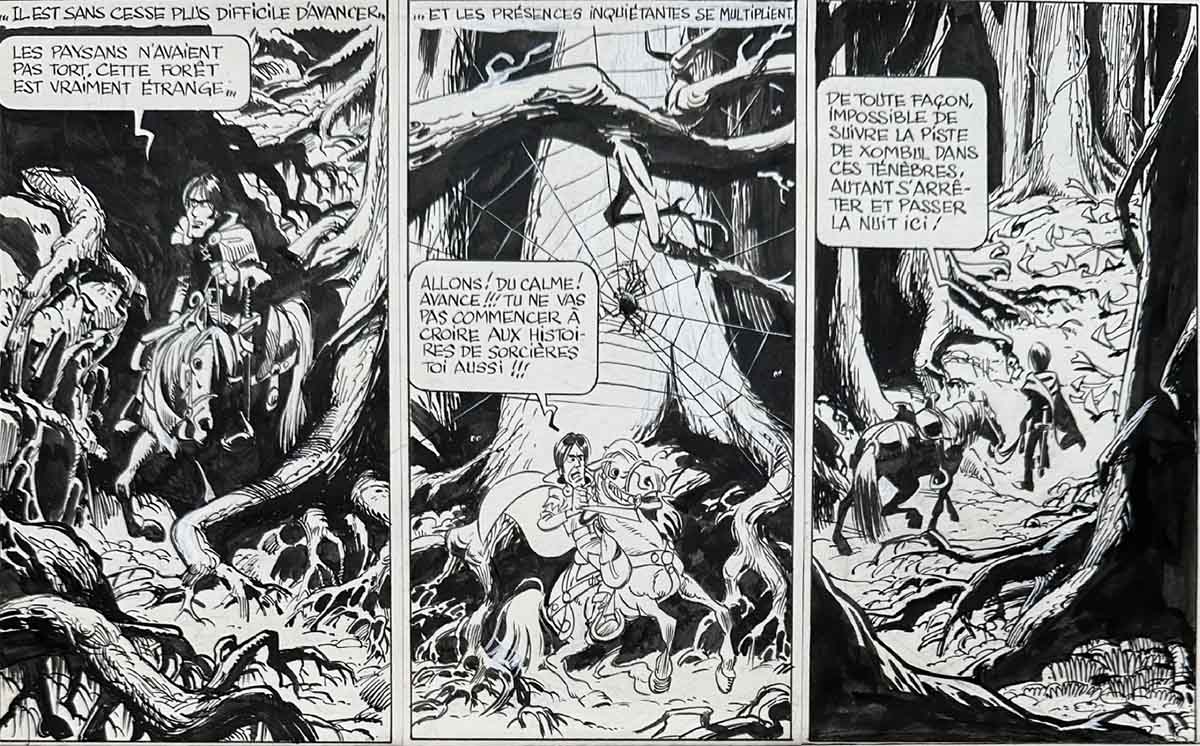10 Comics and Graphic Novels Every Science Fiction Fan Should Read
Explore the universe of the best sci-fi comics! From "Valérian and Laureline's" time-space adventures to "The Incal's" metaphysical saga, this article is a must-read for every sci-fi fan.

If you're yearning for an escape into the cosmos through the pages of a comic book, you're in for a treat. Fasten your seatbelts for an exciting voyage through the vast universe of the best sci-fi comics ever written.
Whether you're a seasoned spacefarer with calloused fingertips from turning comic pages or a wide-eyed rookie just stepping onto the launchpad, this list has something to ignite your imagination.
No. 1: Valérian and Laureline
The dynamic duo of writer Pierre Christin and artist Jean-Claude Mézières crafted the "Valérian and Laureline" comic.
The story is a gem in science fiction comics that has dazzled readers since its debut in 1967. This French series takes you on a rollercoaster ride across time and space, following the adventures of Valérian, a spatio-temporal agent, and Laureline, his intelligent and intrepid partner from the medieval past. The series is a masterful blend of imagination, humor, and a vivid portrayal of alien cultures and worlds.

The artwork, courtesy of Mézières, is nothing short of a visual feast, with each panel bursting with detail and color, making the strange and fantastical settings of "Valérian and Laureline" come alive.
Christin's storytelling, meanwhile, is both pioneering and thought-provoking, weaving intricate plots that explore a wide range of themes, from politics and society to environmentalism, all while maintaining a sense of adventure and fun.
"Valérian and Laureline" has had a strong influence on the science fiction genre, making it a must-read for science fiction fans.
The series has inspired countless works, including notable films and other comics, with its innovative concepts, imaginative technology, and its vision of a complex, often satirical universe.
The dynamic between the cerebral Laureline and the more traditional hero Valérian adds a depth to character development rarely seen at the time of its inception. For fans of space opera and time travel, "Valérian and Laureline" is not just a read; it's an essential pilgrimage to the roots of contemporary science fiction storytelling.
No. 2: The Incal
"The Incal" is a tour-de-force of science fiction storytelling. The brainchild of Chilean-French writer Alejandro Jodorowsky and French artist Moebius (Jean Giraud), this comic series stands as a monumental achievement in graphic novels, first gracing the pages in the early 1980s.
At its core, "The Incal" is an epic adventure that intertwines themes of metaphysics, politics, and spirituality, all set in a richly imagined, far-future universe.
The narrative follows John Difool, a lowly class "R" detective, who inadvertently becomes the keeper of the Incal, a mysterious and powerful artifact. The story catapults from this point into an expansive saga involving a vast array of characters from various factions, each vying for the control of the Incal. Jodorowsky's storytelling is as inventive as it is complex, weaving a grandiose and deeply personal tale.
Moebius' art, renowned for its detail and imaginative scope, brings this universe to life with unparalleled skill, creating landscapes and characters as bizarre as they are enthralling.
Science fiction fans will particularly enjoy The Incal for its visionary approach to the genre. The series has been influential in shaping science fiction not just in comics, but in broader media, inspiring elements in films and other visual arts.
The blend of philosophical inquiry, political intrigue, and the exploration of consciousness makes it a thought-provoking read, while Moebius' art ensures it's a visually stunning journey. For those who appreciate the blend of profound, abstract ideas with expansive world-building, "The Incal" is a must-read, a cornerstone in the pantheon of science fiction literature.
No. 3: Dan Dare, Pilot of the Future
This one is a seminal British science fiction comic series that first appeared in the Eagle magazine in 1950.
Created by Frank Hampson, who also contributed much of the original artwork, "Dan Dare" is set in the futuristic 1990s and introduces us to Colonel Dan Dare, a gallant, square-jawed astronaut, and chief pilot of the Interplanet Space Fleet.
The series is a quintessential example of post-war British optimism about space and technology, infused with a sense of adventure and duty.
The stories of "Dan Dare" are set against the backdrop of a technologically advanced future where space travel is common, and humans are exploring and colonizing the planets of our solar system.
Dare, often accompanied by his trusty sidekick Digby and a cast of characters like Professor Peabody and the Mekon - the series' iconic green, super-intelligent villain from the planet Venus - navigates through a variety of interplanetary conflicts and adventures.
The artwork, especially in the early years under Hampson's direction, is notable for its meticulous detail and vibrant use of color. It brought to life the futuristic technology and alien landscapes in an unparalleled way at the time.
The series was also groundbreaking in its scientific realism; Hampson and his team put considerable effort into ensuring the science behind the fiction was as accurate as possible given the knowledge of the day.
Science fiction fans will appreciate "Dan Dare" for its historic significance in the genre, as well as its imaginative storytelling and pioneering artwork. It's a window into the hopes and dreams of the space age as seen from the mid-20th century, and it retains a timeless charm and sense of adventure.
The series offers a nostalgic trip for older fans and a foundational text for understanding the evolution of science fiction in popular culture.
No. 4: Nexus
Writer Mike Baron and artist Steve Rude skillfully weave together a captivating blend of science fiction and superhero elements in "Nexus."
First appearing in 1981, this comic series is set in a richly imagined future universe and follows the story of Horatio Hellpop, known as Nexus. Hellpop, a complex and reluctant hero, is bestowed with incredible powers by a mysterious alien force. His mandate was to seek out and execute mass murderers. However, this duty's moral dilemmas and psychological consequences are central themes in the series.
Its deep exploration of themes like justice, power, and the toll of carrying such a heavy responsibility sets "Nexus" apart. Horatio's struggles with his conscience and his role as a judge, jury, and executioner make for a compelling narrative.
The series is also notable for its rich supporting cast, including Sundra Peale, a journalist and Nexus's love interest, and a host of other well-developed characters that add depth and complexity to the story.
Steve Rude's artwork in "Nexus" is simply stunning. His clean, dynamic, and expressive style brings the world of Nexus to life with vibrant energy. The futuristic settings and character designs are imaginative and detailed, creating a visually engaging experience that complements Baron's storytelling.
No. 5: Orbiter
Warren Ellis wrote "Orbiter," a gripping graphic novel that Colleen Doran illustrated. This novel offers a unique and thoughtful exploration of the wonders and mysteries of space exploration.
Released in 2003, this standalone graphic novel presents a compelling narrative that blends hard science fiction with a deep sense of wonder and intrigue.
The story begins with the unexpected return of the space shuttle Venture, which had mysteriously disappeared ten years earlier with its crew. The shuttle, coated in a skin of what appears to be living tissue, lands at Kennedy Space Center with only one surviving crew member and a cargo hold full of sand. A team of experts, including a disgraced astronaut, a NASA psychiatrist, and an engineer, is hastily assembled to investigate this enigmatic occurrence. As they delve into the mystery, they uncover remarkable secrets about what happened to the Venture and where it had been, leading to profound revelations about space travel and humanity's place in the universe.
Warren Ellis, known for his sharp and intelligent writing, crafts a narrative in "Orbiter" that is both scientifically grounded and filled with a sense of awe at the vastness of space. Colleen Doran's artwork complements Ellis's storytelling beautifully, with detailed and realistic depictions of technology and human emotion set against the backdrop of the infinite cosmos.
Science fiction fans will be drawn to "Orbiter" for its realistic portrayal of space travel and its visionary take on the future of human exploration. The graphic novel's attention to scientific detail and philosophical underpinnings make it a thought-provoking read. It celebrates human curiosity and the relentless pursuit of knowledge, themes that resonate deeply within the sci-fi community. "Orbiter" is a must-read for anyone who looks up at the stars and dreams of what lies beyond.
No. 6: The Metabarons
Writer Alejandro Jodorowsky and artist Juan Giménez created the captivating and epic space opera, "The Metabarons," which is considered a masterwork of the genre.
First appearing in 1992, this series is a spin-off of Jodorowsky's earlier work, "The Incal," but it stands on its own as a monumental graphic novel.
The narrative of "The Metabarons" chronicles the extraordinary lives and battles of the Metabarons, a dynasty of perfect warriors. Each Metabaron, from generation to generation, is compelled to surpass his predecessor in strength, skill, and ruthlessness. The story delves deep into themes of honor, power, sacrifice, and the cyclical nature of violence, all set against a backdrop of a universe rich in mythology and complexity. The Metabarons are not just warriors; they are symbols of the ultimate pursuit of excellence and the tragic consequences that often accompany such quests.
Juan Giménez's artwork in "The Metabarons" is often spectacular. His detailed and dynamic illustrations bring the grandeur and brutality of the Metabaron's universe to life, with each panel exuding a sense of scale and intensity. The intricate designs of the technology, the alien landscapes, and the character portrayals all contribute to an immersive and visually stunning experience.
Science fiction fans will be drawn to "The Metabarons" for its bold storytelling, complex characters, and philosophical depth. Jodorowsky's unique vision combines with Giménez's artistic prowess to create a narrative that's not only epic in scope but also profound in its exploration of the human condition. The series pushes the boundaries of what space opera can be, offering a tale that is as thought-provoking as it is visually spectacular. For those who appreciate a story that challenges both the mind and the senses, "The Metabarons" is an essential read in the science fiction genre.
No. 7: Aldebaran
The French creative duo of writer and artist Leo (Luiz Eduardo de Oliveira) and colorist Rodolphe crafted a captivating comic series called "Aldebaran" that beckons science fiction enthusiasts into an extraordinary interstellar journey.
Originally published in the late '90s, "Aldebaran" introduces readers to a meticulously constructed universe that orbits around the distant star system of Aldebaran.
The narrative unfolds on a colonized exoplanet called Aldebaran-4, where a diverse array of settlers grapple with the mysteries of alien flora and fauna.
As the plot unfurls, the series seamlessly intertwines elements of science fiction, environmental exploration, and human drama, encapsulating the essence of speculative storytelling.
Leo's masterful world-building and detailed artwork, complemented by Rodolphe's vibrant coloring, create a visually immersive experience that will resonate with science fiction aficionados.
The series delves into themes of survival, the unknown, and the resilience of the human spirit, offering readers a rich tapestry of both extraterrestrial wonders and relatable human narratives.
With a narrative that effortlessly blends high-stakes space exploration, intricate character development, and a touch of mystery, Aldebaran stands as a testament to the power of the medium in capturing the imagination of science fiction fans.
Whether it's the allure of exploring uncharted planets or the intricacies of interstellar relationships, "Aldebaran" offers a compelling and visually stunning adventure that will leave science fiction enthusiasts eagerly turning the pages.
No. 8: Appleseed
Masamune Shirow, the legendary manga artist, wrote the iconic series "Appleseed," which stands as a cornerstone in science fiction comics, seamlessly blending futuristic technology, political intrigue, and cyberpunk aesthetics to provide an intricate narrative.
First serialized in 1985, "Appleseed" has since become a seminal work in the cyberpunk genre, exploring themes of artificial intelligence, cybernetics, and the impact of technology on society.
Set in a post-apocalyptic world, the series follows the adventures of Deunan Knute and her android companion Briareos as they navigate the complexities of a city-state known as Olympus, a utopian metropolis teetering on the brink of social and political upheaval.
Shirow's meticulous attention to technological detail and his ability to craft intricate plots make "Appleseed" a must-read for science fiction enthusiasts.
The series not only explores the potential consequences of advanced technologies but also delves into philosophical questions about the nature of humanity and the ethical implications of artificial intelligence. With its dynamic action sequences, thought-provoking themes, and Shirow's distinctive artistic style, "Appleseed" offers science fiction fans a compelling and immersive experience.
Whether it's the exploration of futuristic landscapes, the examination of human-technology integration, or the riveting political intrigue, "Appleseed" provides a rich and multi-layered narrative that will captivate and resonate with those who revel in the wonders of speculative fiction.
No. 9: Planetes
Makoto Yukimura created the thought-provoking manga series "Planetes," which invites science fiction enthusiasts on an enthralling journey through the cosmos, exploring the complexities of space travel, human ambition, and the existential questions that arise when reaching for the stars.
Originally serialized from 1999 to 2004, "Planetes" unfolds in a near-future setting where humanity has expanded its reach into outer space.
The narrative centers around the crew of the debris collection ship, the Toy Box, tasked with the crucial yet often overlooked job of clearing Earth's orbital pathways of space junk.
Yukimura's storytelling prowess and meticulous attention to scientific detail distinguish "Planetes" as a compelling read for science fiction fans. The series not only delves into the challenges of space exploration but also explores the human condition, societal dynamics, and the consequences of technological advancement.
With a focus on character development, moral dilemmas, and the intersection of personal aspirations with the broader scope of space exploration, "Planetes" offers a nuanced and emotionally resonant narrative that goes beyond the traditional trappings of the genre.
Science fiction enthusiasts will appreciate the series for its realistic portrayal of space travel, its philosophical undertones, and its ability to blend hard science with a captivating human story, making it a must-read for those who seek a thoughtful and engaging exploration of the final frontier.
No. 10: Universal War
French artist and writer Denis Bajram created "Universal War," a gripping science fiction comic series that catapults readers into an intense, visually stunning space opera.
First published in 1998, the series unfolds in the 31st century, where a mysterious wall of dark energy appears at the edge of the universe, threatening the fabric of space and time.
As tensions escalate among Earth's major powers, an elite team of specialists is dispatched to investigate the anomaly. Led by the enigmatic Captain Tazio Menegaz, the team unravels a web of conspiracies, uncovering shocking truths about the universe and humanity's place within it.
Denis Bajram's intricate plot and cinematic artwork, characterized by detailed spacescapes and dynamic action sequences, make "Universal War One" compelling for science fiction enthusiasts.
The series explores complex themes of war, political intrigue, and the consequences of scientific curiosity, creating a narrative that combines hard science fiction elements with a thrilling and suspenseful storyline.
Fans of the genre will appreciate the depth of world-building, the exploration of speculative scientific concepts, and the moral dilemmas faced by the characters.
"Universal War One" is a visually stunning and intellectually engaging series that captures the essence of epic space exploration, offering a rich experience for those who crave immersive and thought-provoking science fiction narratives.

